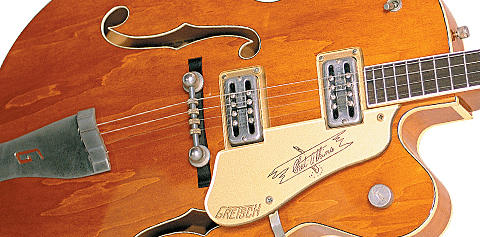 PRS Guitars’ P245 uses an LR Baggs/PRS piezo and provides both electric and authentic acoustic tones in one instrument. It can be plugged into an amplifier or plugged direct to a mixer. Using a Blend control, its 58/15 pickups can be combined with its acoustic tones through a single output. It has 24.5″ scale length and 22 frets, figured-maple top, and mahogany back with binding, mahogany neck, rosewood fretboard with bird inlays, nickel hardware, volume, tone and three-way toggle switch. Visit www.prsguitars.com.
PRS Guitars’ P245 uses an LR Baggs/PRS piezo and provides both electric and authentic acoustic tones in one instrument. It can be plugged into an amplifier or plugged direct to a mixer. Using a Blend control, its 58/15 pickups can be combined with its acoustic tones through a single output. It has 24.5″ scale length and 22 frets, figured-maple top, and mahogany back with binding, mahogany neck, rosewood fretboard with bird inlays, nickel hardware, volume, tone and three-way toggle switch. Visit www.prsguitars.com.
Year: 2014
-
PRS Introduces P245 Model
-
Electro-Harmonix Introduces C9 Organ Machine
 The EHX C9 Organ Machine has nine presets that allow the player to select among popular organ types and pay homage to tones made famous by Keith Emerson, Ray Manzarek, Jon Lord, the Beatles, Led Zeppelin, and more. Its Organ Volume knob controls overall volume of the organ preset while Dry Volume controls the volume of the untreated instrument level. The Mod control adjusts speed of the modulation, while Click controls the percussive click level or a parameter unique to the preset such as upper harmonic level or modulation. Learn more at www.ehx.com.
The EHX C9 Organ Machine has nine presets that allow the player to select among popular organ types and pay homage to tones made famous by Keith Emerson, Ray Manzarek, Jon Lord, the Beatles, Led Zeppelin, and more. Its Organ Volume knob controls overall volume of the organ preset while Dry Volume controls the volume of the untreated instrument level. The Mod control adjusts speed of the modulation, while Click controls the percussive click level or a parameter unique to the preset such as upper harmonic level or modulation. Learn more at www.ehx.com. -

Jimmy McIntosh
While guitarists in high-profile bands get the lion’s of share of publicity, the working stiffs who slug it out on local stages get no love. Las Vegas sideman Jimmy McIntosh is one of those working stiffs, and he deserves your affection.
This album is a smorgasbord of stank-filled grooves and funky textures. It’s a star-studded affair as McIntosh shares guitar duties with Ron Wood, John Scofield, and Mike Stern. Organist Ivan Neville adds New Orleans sauce to McIntosh’s graduate-level blend of blues, jazz, and fusion.
“Lavona’s Boogie” and “Letsco” showcase contrasting styles as McIntosh and Scofield improvise over NOLA second-line grooves in all their behind-the-beat glory. Stern is unmistakable on “PM Blues” and “Back2Cali,” as the two monsters converse eloquently within familiar New York fusion territory.
And… is also a great sounding record. Human interaction is prevalent. Wood plays with primitive economy on three cuts, while McIntosh is a consummate harmonic surfer à la Oz Noy, who can simplify or fuse out with interplanetary virtuosity. The spectacular rhythm section with Toss Panos on drums inspires, while McIntosh plays using his brain as well as his heart.
This article originally appeared in VG‘s January ’15 issue. All copyrights are by the author and Vintage Guitar magazine. Unauthorized replication or use is strictly prohibited.
-
ThroBak Electronics Releases Pre-T-301 Pickup
 The ThroBak Electronics Pre-T-301 Maximum Vintage humbucker is hand-made and wound in the U.S. using a vintage Meteor ME-301 winder and 42 AWG red-poly wire, Alnico II and V magnets, Butyrate bobbins, PAF-style baseplates and covers, and braided lead wires. The company says it it designed to deliver tones very similar to a mid-/late-’60s Gibson ES-335 and/or SG. See them at www.throbak.com.
The ThroBak Electronics Pre-T-301 Maximum Vintage humbucker is hand-made and wound in the U.S. using a vintage Meteor ME-301 winder and 42 AWG red-poly wire, Alnico II and V magnets, Butyrate bobbins, PAF-style baseplates and covers, and braided lead wires. The company says it it designed to deliver tones very similar to a mid-/late-’60s Gibson ES-335 and/or SG. See them at www.throbak.com. -
Jeff Beck Sets Spring Tour Dates
 Jeff Beck will headline a string of solo dates beginning April 16 and wrapping up April 26. Beginning April 30, he and ZZ Top will make up the rescheduled dates from September, when the double-bill tour was cut short due to an unfortunate injury to ZZ Top bassist Dusty Hill.
Jeff Beck will headline a string of solo dates beginning April 16 and wrapping up April 26. Beginning April 30, he and ZZ Top will make up the rescheduled dates from September, when the double-bill tour was cut short due to an unfortunate injury to ZZ Top bassist Dusty Hill.Joining Beck are Jimmy Hall on vocals, Rhonda Smith on bass, Jonathan Joseph on drums, and Nicolas Meier on guitar.
Beck has twice been inducted into the Rock and Roll Hall of Fame: once with The Yardbirds in 1992 and once as a solo artist in 2009. He has won numerous Grammy Awards, including two in 2011 for Best Rock Instrumental Performance (“Hammerhead”) and Best Pop Instrumental performance (“Nessun Dorma”) both from his latest studio album, Emotion & Commotion.
-
Eastwood Guitars Launches Link Wray Tribute Guitar
Eastwood Guitars has teamed with artist Vince Ray to create the Link Wray Tribute model. It has professional-grade tuners, pots, a custom tailpiece, three-way switching and dual Volume/Tone controls matched with a pair of Airline Vintage Voiced single-coil pickups. Learn more at www.eastwoodguitars.com.

-
Tone Tubby Offers Chicago Blue Speaker
 Tone Tubby’s Chicago Blue is a 12″/30-watt speaker designed for use with acoustic/electric instruments. It has a 17-ounce Alnico magnet, ribbed hemp cone, and is designed to render articulate midrange and a looser, “spongy” feel that offers great responsiveness whether played clean or pushed into breakup. It is available in 8- and 16-ohm models. Visit www.tonetubby.com.
Tone Tubby’s Chicago Blue is a 12″/30-watt speaker designed for use with acoustic/electric instruments. It has a 17-ounce Alnico magnet, ribbed hemp cone, and is designed to render articulate midrange and a looser, “spongy” feel that offers great responsiveness whether played clean or pushed into breakup. It is available in 8- and 16-ohm models. Visit www.tonetubby.com. -

The Gretsch 6120 Tenor

Photo courtesy of George Gruhn. This 1958 Gretsch Chet Atkins 6120 four-string tenor guitar is a very rare variation of the model.
Gretsch built other tenors, including the Duo Jet, archtop acoustic, and archtop electric tenors of various other models. Gretsch was not alone in making tenors. Martin, Gibson, and Epiphone all produced tenor versions of many of their standard models.
Tenor guitars were popular in the 1930s and continued to be made into the ’70s, though very few were made after the early ’60s. The heyday of the tenor banjo was the 1920s Dixieland era. At that time, they were more popular than guitars in the U.S., as Dixieland music took the nation by storm. The tenor banjo (and to a lesser extent its cousin, the four-string plectrum banjo) were the dominant fretted instruments of the genre.
The tenor banjo has tremendous volume and projection. One can be heard very clearly through a 12-piece brass band. After 1929, Dixieland music declined dramatically in popularity and was replaced by the crooners such as Bing Crosby and Rudy Vallee, who ruled the music scene from 1929 through 1933. From 1934 through World War II, the big-band era was dominant. The tenor banjo had too strident and piercing a voice to suit either the crooners or the Big Band era.
So the guitar became the dominant fretted instrument, with its lower pitch, more mellow voice, and greater sustain. Thousands of tenor banjo players were faced with either being out of work or switching to guitar. Since the banjo has a different tuning, different scale length, and quite different playing technique, it was a big adjustment. For those who wanted an easier transition, the tenor guitar was an alternative.
By putting the equivalent of a tenor banjo neck on a standard guitar body, the tenor banjo player could adapt virtually immediately. But the tenor guitar sounds very different from a tenor banjo. These instruments have a unique voice, combining the voicing of tenor tuning with the greater depth, mellowness, and sustain of a guitar.
While we frequently encounter people playing a tenor guitar tuned the same as the first four strings of a standard guitar, it should be noted that this is not the way the instrument was intended to be used, nor is it the best way to bring out the sound of these instruments. Tuned in standard guitar manner, a tenor guitar simply is a less complete and weaker instrument. The shorter tenor scale (221⁄2″ to 23″ depending upon the manufacturer) is ideally suited to tenor tuning, but does not give sufficient tension to bring out the best in standard guitar tuning.
Four-string tenors are tuned and played in the same manner as a tenor banjo, in fifths, C, G, D, A (low to high). The instrument extends from a low C to a high A (first-string equivalent to the first string on a standard guitar at the fifth fret). The instrument has a far greater pitch range than the first four strings of a guitar, and the chord voicings are far more versatile. Tuned in fifths in the correct tenor manner, the voicings are the same as bowed instruments such as violin and viola or mandolin family instruments (tenor tuning – C,G,D,A – is the same as viola or mandola).
While the tenor guitar has a unique voice, and well-made tenor instruments of this sort sound very fine, they did not fill a niche in the big bands, and never achieved the popularity of a standard guitar. Tenor banjo players who wanted to make the transition to guitar generally found that simply switching to a tenor instrument with a guitar body was not going to assure them of continued employment.
By the 1950s, tenor guitars were made in relatively small quantities and were more of a curiosity than a mainstream instrument. The tenor received a brief boost in the early ’60s due to being featured in the folk group The Kingston Trio, but most folk players never truly understood tenor voicing, and simply tuned them like the first four strings of a standard guitar.
Today, tenor guitars are most popular among players who back up Texas-style fiddling. While the majority of guitarists backing Western Swing and Texas-style fiddlers perform on six-string guitars playing chord rhythm, a minority use tenor guitars and have found them ideally suited to the chord rhythm played in this style of music.
The tenor Gretsch featured here has a body of the same dimensions and construction as the standard 6120 of the period. The tailpiece is a typical Gretsch “G” logo type set up to hold four strings. The Filtertron pickups are built with the same construction as the six-string version, but are set up with only four sets of pole screws. The neck dimensions are essentially the same as a tenor banjo. The peghead is a smaller tenor size, set up for four strings, but features the same Gretsch name logo and horseshoe inlay as the standard 6120 model of the period. When this guitar was made, a typical six-string 6120 would have had “thumbprint” inlays on the bass side of the fingerboard. This has dot inlays, but on an instrument which, in all probability, is a one-of-a-kind custom-order piece, variations are always possible.
This guitar came with a typical Gretsch 6120-style hardshell case with white covering and tooled leather edge trim. While the neck is shorter than a standard guitar, Gretsch did not have a special design tenor case made with a shorter neck. Had Gretsch tooled up to make large numbers of tenor guitars, they might have had special tenor cases made, but for a custom instrument such as this, they made do with the standard case.
This guitar is in exceptionally fine condition showing virtually no wear. Today, it is owned by Elvis Costello, who has been performing with it onstage. While the tenor guitar will never overcome the standard six-string in popularity, they have a valid voice, deserving of greater recognition.
Learn more about George Gruhn at Gruhn Guitars.
This article originally appeared in Vintage Guitar magazine’s August 2004 issue. All copyrights are by the author and Vintage Guitar magazine. Unauthorized replication or use is strictly prohibited.
-

Big Star
Big Star’s star shone only briefly. The band formed in Memphis in 1971 around guitarists-songwriters Chris Bell and Alex Chilton, and then blazed out by ’74 despite rave critical reviews and two stellar albums. But the band’s renown has only ascended from there.
In the ’80s, post-punk and alt-rock hipsters championed Big Star as one of the great misunderstood and forgotten bands; REM, the Replacements, the Posies, and more sang their praises – literally, in the case of Paul Westerberg’s hard-rocking paean “Alex Chilton.”
For his part, Chilton never quite got what the afterglow was about. In 1992, he told an interviewer, “People say Big Star made some of the best rock and roll albums ever. And I say they’re wrong.” Could have been undiluted band-breakup heartache, just a bad day, or maybe honest humility.
Happily, the band’s music is now back. Their first two albums – #1 Record from ’72 and Radio City from ’74 – are reissued in remastered, stand-alone form. Songs such as “The Ballad of El Goodo” and the power-pop masterpiece “September Gurls” sound fresh all over again, the guitars and stunning mix of raw and sweet. These albums are textbooks for pop guitarists: Bell and Chilton could really write a hook.
The band’s short, sad story is told in directors Drew DiNicola and Olivia Mori’s recent documentary Big Star: Nothing Can Hurt Me, now out on home DVD. After the frustrations and failure of their promising first album, the band fell apart amid a series of knockdown punch-ups and vandalized instruments.
Chilton, bassist Andy Hummel, and drummer Jody Stephens reformed the band, recorded Radio City – oddly, with song contribution from the ousted Bell – and then broke up again.
Their Third album, cut in ’74 by Chilton and Stephens with producer Jim Dickinson, was both an experimental venture and a chronicle of Chilton’s declining mental health.
Several live albums of the original lineup were released in the ’90s and later, but the new Live in Memphis captures a band reunion show on October 29, 1994. The collection is available on double LP, CD, and pro-filmed DVD.
This article originally appeared in VG‘s January ’15 issue. All copyrights are by the author and Vintage Guitar magazine. Unauthorized replication or use is strictly prohibited.
-
Tech 21 Intros Kotzen Signature Fly Rig 5
 The Tech 21 Richie Kotzen RK5 Signature Fly Rig has an overdrive section tuned per Kotzen’s specs and employing a Class-A-style distortion, and otherwise offers the same features as the company’s Fly Rig 5, including an all-analog SansAmp with effects including reverb, delay with tap tempo, adjustable tape drift-style modulation, and boost with up to 21dB of additional pre-amp gain. Learn more at www.tech21nyc.com.
The Tech 21 Richie Kotzen RK5 Signature Fly Rig has an overdrive section tuned per Kotzen’s specs and employing a Class-A-style distortion, and otherwise offers the same features as the company’s Fly Rig 5, including an all-analog SansAmp with effects including reverb, delay with tap tempo, adjustable tape drift-style modulation, and boost with up to 21dB of additional pre-amp gain. Learn more at www.tech21nyc.com.






